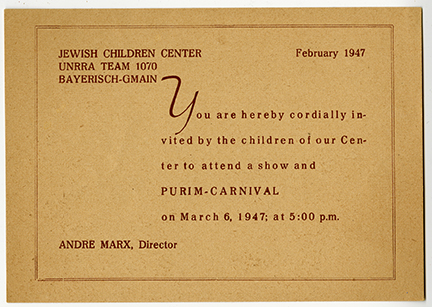Purim is a holiday commemorating the survival of the Jewish people in ancient Persia after a royal decree called for their extinction. Jews around the world have long celebrated Purim by reading the Megillah (scroll) of Esther, dressing up in costumes, and drinking and eating joyfully.
Although Purim rituals are often lighthearted, the story of the holiday offers serious messages about antisemitism and identity that have resonated during more recent chapters of Jewish history, including the Holocaust and the persecution of Jews in the Soviet Union. The Museum’s collection includes several artifacts that highlight how Jews have observed Purim during these chapters.

One such artifact is an invitation to a Purim carnival at a Displaced Persons (DP) camp for Jewish children in Bavaria, dated February 1947. The camp was run by the United Nations Relief and Rehabilitation Administration (UNRRA) under the direction of Andre Marx, a Jewish man who had once been the Chief Cantor of Luxembourg and survived the war with his family in Switzerland. Many of the children at the “Jewish Children’s Center” were orphans, having lost their parents during the Holocaust. Holiday celebrations were one of the ways that camp leaders like Marx sought to rehabilitate the children, providing an opportunity for Jewish education as well as establishing a sense of normalcy.
(Athletics were another way that the UN and Allied forces sought to rehabilitate young Jewish survivors in DP camps after the war. Learn more here.)

The Museum’s collection also includes a Purim pamphlet printed in 1974 by the Association of Russian Immigrants in Israel in cooperation with Israel’s Ministry of Absorption. The pamphlet, printed in both Russian and Hebrew, was used to educate Jews who had escaped persecution in the Soviet Union and found refuge, as well as Jewish identity, in Israel.
For these refugees, much like Andre Marx and the children at his “Jewish Children’s Center” who survived the Holocaust, the story of Purim offered lessons that may have felt particularly close to home.
Explore the slideshow below to see other Purim artifacts from the Museum’s collection.